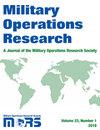Semi-Supervised Approach to Predictive Analysis Using Temporal Data
IF 0.3
4区 管理学
Q4 OPERATIONS RESEARCH & MANAGEMENT SCIENCE
引用次数: 1
Abstract
redicting a target event from temporal data using supervised learning alone presents a number of chal-lenges. It assumes that members falling into the same class have similar historical characteristics, which is a too strong an assump-tion. Additionally, it can be difficult for the algorithm to underline the differences from a large volume of data and multitude of temporal projections. In such situations, a combination of supervised and unsupervised learning proved to be superior in performance as compared to supervised learning alone. In the proposed methodology, we develop feature vectors of temporal events that are subsequently split into groups by similarity of spatio-temporal characteristics using a clustering algorithm. We then apply a supervised learning methodology to predict the class within each of these subpopulations. We show a dramatic improvement in predictive power of this joint methodology as compared to supervised learning alone. The case study that we use to demonstrate the methodology utilizes medical claims data to predict a patient’s short-term risk of myocardial infarction. In particular, we identify groups of people with temporal diagnostic patterns associated with a high-risk of myocardial infarction in the coming three months. We use these patterns as a profile reference for assessing the state of new patients. We demonstrate that the newly developed combined approach yields improved predictions for myocardial infarction over using classification alone.基于时间数据的半监督预测分析方法
仅使用监督学习从时间数据中预测目标事件就存在许多挑战。它假设属于同一类的成员具有相似的历史特征,这是一个过于强烈的假设。此外,算法很难强调大量数据和大量时间预测之间的差异。在这种情况下,与单独的监督学习相比,监督学习和无监督学习的结合被证明在性能上更优越。在提出的方法中,我们开发了时间事件的特征向量,然后使用聚类算法根据时空特征的相似性将其分成组。然后,我们应用监督学习方法来预测这些亚群中的每个类。与单独的监督学习相比,我们展示了这种联合方法在预测能力方面的显着改进。我们用来演示该方法的案例研究利用医疗索赔数据来预测患者的短期心肌梗死风险。特别是,我们确定了在未来三个月内与心肌梗死高风险相关的时间诊断模式的人群。我们使用这些模式作为评估新患者状态的资料参考。我们证明,新开发的联合方法比单独使用分类可以提高对心肌梗死的预测。
本文章由计算机程序翻译,如有差异,请以英文原文为准。
求助全文
约1分钟内获得全文
求助全文
来源期刊

Military Operations Research
Engineering-Mechanical Engineering
CiteScore
0.40
自引率
0.00%
发文量
0
期刊介绍:
Military Operations Research is a peer-reviewed journal of high academic quality. The Journal publishes articles that describe operations research (OR) methodologies and theories used in key military and national security applications. Of particular interest are papers that present: Case studies showing innovative OR applications Apply OR to major policy issues Introduce interesting new problems areas Highlight education issues Document the history of military and national security OR.
 求助内容:
求助内容: 应助结果提醒方式:
应助结果提醒方式:


